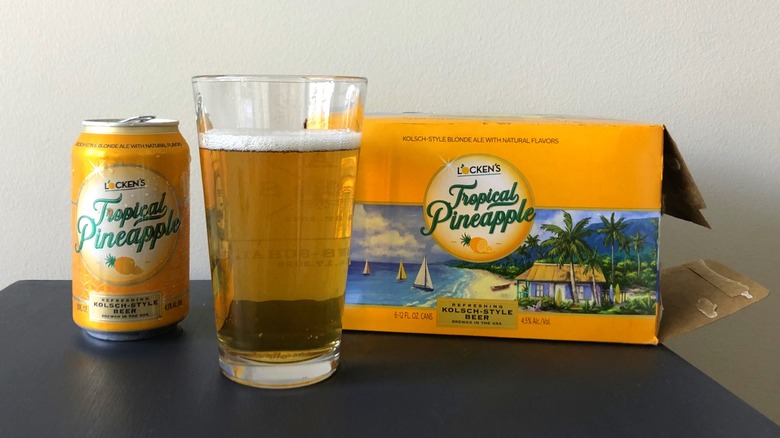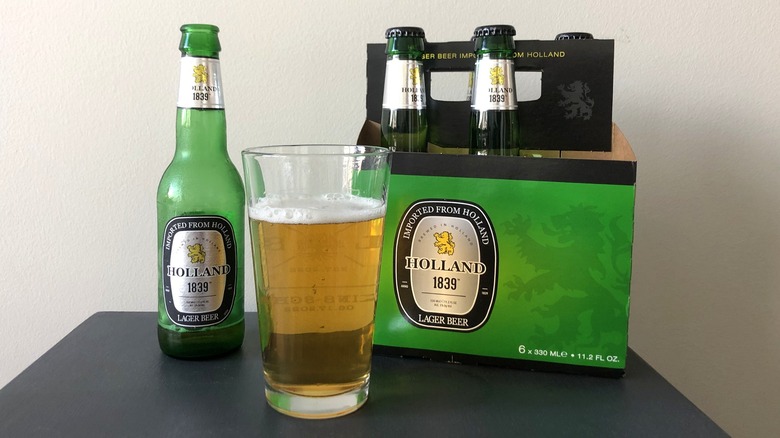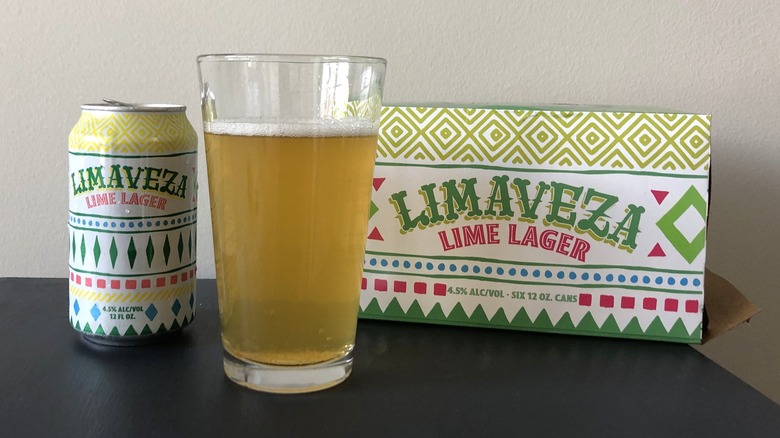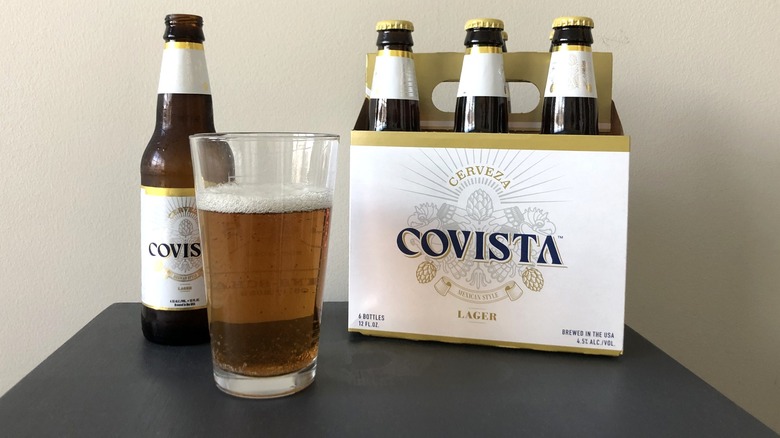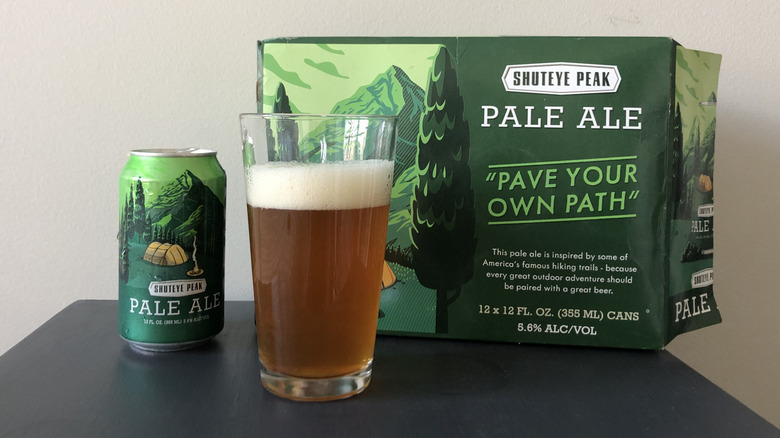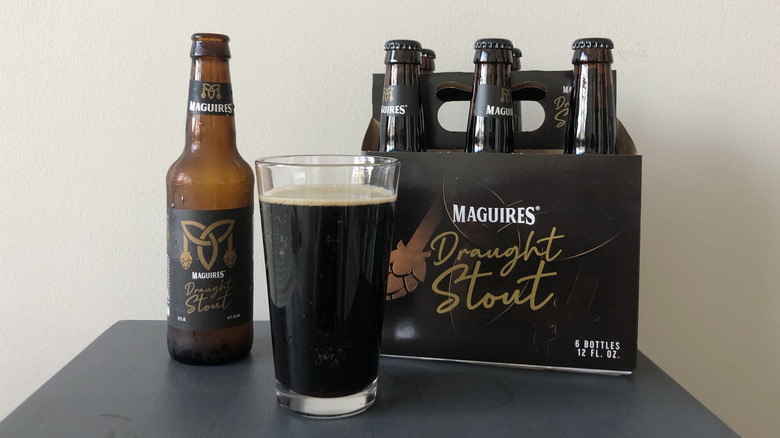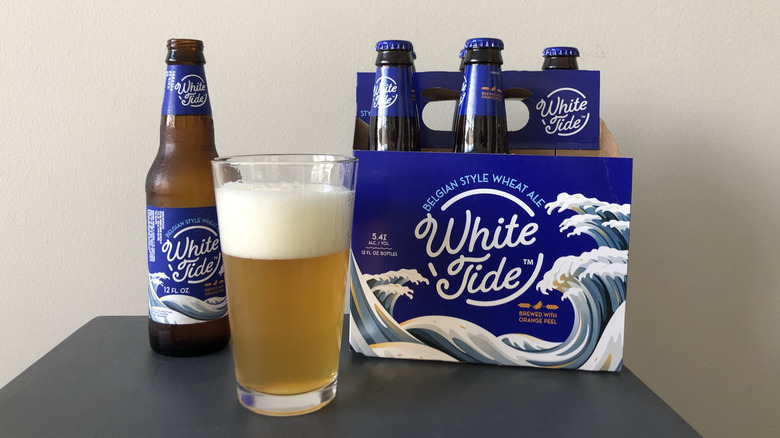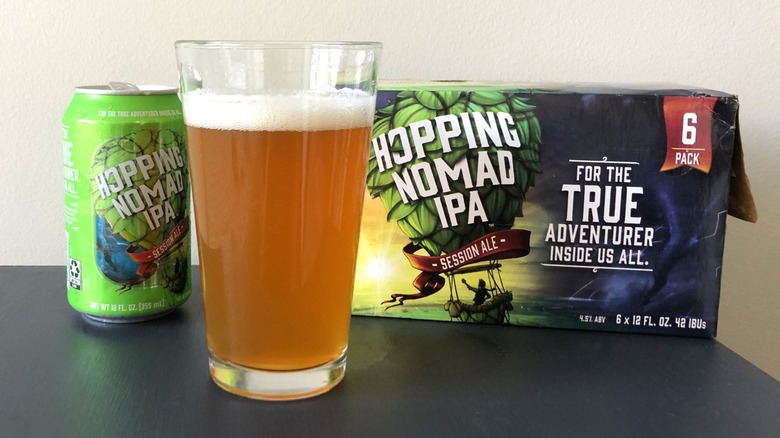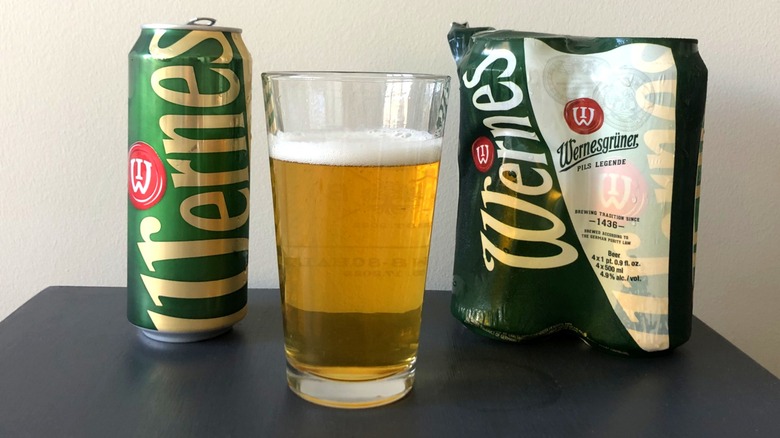9 Aldi Beers, Ranked Worst To First
There's no place quite like Aldi. The German-based grocery store marches to the beat of its own drum, trading frills for function and name brands for low prices. Throw in a quarter requirement for carts and an ahead-of-its-time reusable bag policy, and it's clear it's in a market category all its own.
It should come as no shock that the Aldi beer aisle follows the same ethos of simplicity and unpretentiousness. I also use the word "aisle" incredibly loosely — limited end cap or micro-display are more like it — and here, you won't find beer giants like Budweiser or Heineken taking up real estate. In fact, you won't find too many names at all — I counted just nine total options at my local store in Columbus, Ohio.
Despite that, this brew selection is mighty. It incorporates beers of all kinds, from hoppy IPAs and light lagers to fruit-splashed ales and robust stouts. Influence comes from all over as you take a short world tour to countries like Mexico, Belgium, and, of course, Germany. Aldi's beers are even award-winning, accumulating medals at competitions like the World Beer Awards.
As a passionate beer drinker, I recently schlepped home all nine of my nearest Aldi's available bottles and cans — not for a party filled with diverse palates, but for a little taste test of my own. Asking simple questions like "Would I drink this again?" and "Is it a good beer or just a good price?", I crafted an ultimate ranking, from bad to certified lawnmower beer to best. Bottoms up.
9. Locken's Tropical Pineapple Kolsch Beer
This Kolsch beer is brewed by Rock Wall Brewing Company and is sweetly acidic, courtesy of tropical pineapple. With roots in Cologne, the Kolsch beer lands somewhere between a pale ale and a lager. The balance and light body place it in the broader blonde ale category, which I've found to be somewhat of a gateway category for craft beer. The look of this beer further assures you of its approachability. A golden tint complements the yellow-orange color of the can, but translucence is maintained. The small head is surprising for a beer typically known for its effervescence — the only surface feature that gave me pause.
Natural fruity esters are clearly at play, and a bready malt is more obvious than the hops. But all of this becomes mere background noise as strong overtones of pineapple rush onto the scene. These aren't your average La Croix-style flavor whispers, but juicy waves of sweetness and artificiality. This is what I imagine a Leinenkugel's Summer Shandy would taste like if it were a bit lighter and took too long a soak in a tropical bath.
This seasonal summer beer has good bones. But a partiality to pineapple is crucial for appreciating a can in its entirety. And I don't just mean that you enjoy the occasional fresh slice of the fruit. I mean the kind of obsession where you're buying bags of purely pineapple-flavored Haribo gummy bears and asking for your pina coladas sans the coconut and cream.
8. Holland Lager
I had a severe lack of taste notes on this imported Holland lager. And after going back for another crack at the cold one, I realized it's because it simply doesn't offer many notable characteristics. Admittedly, it does have an easy, quaffable quality, but I couldn't help feeling like I needed something more as I sipped on the diluted suds.
At a glance, this beer appears to be nothing more than a Heineken dupe. The green-tinted bottle and "HOLLAND" emblazoned on the bottle are more than enough evidence. I would even venture to guess that Holland Lager also makes use of Heineken's signature ingredients, including a careful combination of malted barley, hop extract, and water. However, what Holland is missing is that distinctly strong yet refreshing quality that the Amsterdam-born beer has built its global brand upon.
A subtle metallic taste, lack of bitterness, and the founding date on the side of the bottles further differentiate this beer from its "competitor." Holland reveals that it got its start nearly two centuries ago, in 1839, while Heineken didn't bubble up until 1864. So, perhaps it was Heineken that built upon Holland's rudimentary recipe of malt and noble hops. I'm looking for a little more from my brews than a hint of light crisp and 5% ABV. But, if that's your style, then proost (cheers) to you.
7. Limaveza Lime Lager
Lime and lagers (particularly the Mexican kind) are a match made in beer heaven. Somewhere along the line, an enterprising bartender dropped a slice into a frosty bottle, complementing the refreshing flavors and changing summer beer forever. Now, it's hard to imagine a Pacifico, Sol, or Corona without lime wedge hats. Other brands have attempted to replicate this experience by infusing lime right into the bottles and cans. Unfortunately, this hardly ever breeds the same level of vacation-state-of-mind succulence, and the Limaveza take from Aldi is no different.
The Limaveza's lime taste is bold from the start and lingers on the sweet malt body like a thick film. Zest is to be expected, but it tastes more like the imitation juice you would squeeze from one of those plastic limes or a bottle of Bud Light Lime. Despite its shortcomings, I could see myself buying Limaveza again. Its colorful, pattern-filled design is enough to draw me back in — looks and labels drive many of my craft beer and wine purchases, if we're being honest. And next time, I would simply lower my expectations, knowing the Mexican-style lager I'm getting is far from fresh-squeezed and not Mexican-made at all, but brewed and canned in the U.S.
6. Covista Mexican Style Lager
If you ask me, I would say ditch the Limaveza citrus-splashed lager and go with a bottle of Covista instead. It's a no-nonsense type of cerveza. There are no built-in flavor notes of fruit or spice or the like — though a lime slice could always be thrown in. It doesn't try to be fancy or something new and inspired. It's a cheap Mexican lager, and it tastes like such.
One may assume that it takes after Corona, and it's a fair guess considering the beer classification and even the similar-sounding names, but I found the taste to be a mix between Dos Equis and Corona Light. It's exceedingly understated. Instead of a malt flavor, though, or the kind of distinct skunkiness that sometimes accompanies light Mexican beers, it presents a modest amount of sweet hoppiness.
Judging solely by the coloring of a Covista, I wouldn't have guessed it was a light lager at all. I was surprised by the deeper, golden hue that came gushing out of the bottle. It was still transparent, though. It also produced a notably small head that was more like froth than foam and that vanished almost as fast as it appeared. Looks and comparisons aside, Covista offers an agreeable palate and decent carbonation — what more could you want from a well-priced Aldi beer? Its crispness and laid-back demeanor also make it particularly well-suited for everyday, light sipping outside.
5. Shuteye Peak Pale Ale
Pale ales are a great alternative to India pale ales (IPAs) for those times when you're trying to evade the mouth-assaulting bitterness and can-only-have-one alcohol levels. I turn to them in times of indecision at local microbreweries, and this Shuteye Peak brew is just the kind of thing I would have expected to find in my glass — though a less refined interpretation.
As an American pale ale, it sports an inviting amber hue. However, the taste reveals that Shuteye is not as nuanced as others in its category. It begins with malt and subdued hops before settling into light earthiness and juiciness — more so from citrus than anything else. I can appreciate its low bitterness, but at the same time, I wish it was punchier.
Saying that, the combination of smooth mouthfeel, medium body, and light carbonation adds up to an enjoyable beer, and evokes the same serenity portrayed on the packaging. The box says the ale was inspired by America's hiking trails, "because every great outdoor adventure should be paired with a great beer." The word "great" is perhaps a stretch, but I could enjoy a can by a glowing campfire under the stars — a reliable nightcap before getting some "shut-eye" in the great outdoors.
4. Maguires Draught Stout
After spending a week in Ireland and fruitlessly attempting to "Split the G", it was difficult to approach Maguires through an objective lens. Guinness beer just has that roasted and creamy je ne sais quoi that's difficult to compete with, but Maguires does its darndest.
With a deep, nearly black shade and obvious murkiness, there's no doubt it's a stout. It doesn't have that thick and marvelous band of foam at the crest like Guinness does (a result of nitrogen used in the brewing process). But there's at least a sliver of something to work with up there. Inflections of chocolatey Tootsie Rolls were first to hit my nostrils, but this flavor dissipates on the tongue. The Coke-colored liquid goes down light and then blossoms into more richness on the backend. It's a bit Java-like but also thin and more acidic than smooth. The sturdy robustness that I was hoping for was absent — with just a touch more body, it could have been one of my top picks.
It's never going to be a "Lovely Day for a Maguires," but it's an adequate Guinness imitator. If nothing else, you also get a small sampling of how beer is done across the pond. Irish stouts have their own style, and despite being brewed by State of Brewing in Wisconsin, Aldi brings some of that unique flavor Stateside.
3. White Tide Belgian Wheat Ale
If a Belgian-style wheat ale brewed with orange peel and coriander sounds familiar, it's because it is. Meet the Aldi version of a Blue Moon. One could also argue that it matches the profile of a juicy Shock Top. But White Tide's lack of extra citrus notes from both limes and lemons pushes that comparison farther from mind.
As soon as you pour out the discount grocer's rendition, you can tell it fits the bill for a classic Belgian-born white ale, or witbier. It's certainly hazy with a high opacity, light orange tinge, and thick band of foam resting on top (although my poor pouring skills could partly be to blame here). On your palate, the orange flavor wrestles with wheat all the way through, just as it does in the Blue Moon. I wouldn't describe it as phenolic — the coriander and any other hints of spice are kept to a minimum.
Some find it hoppier than a Blue Moon. Personally, I think the two are nearly identical in this department. But what I will say is that White Tide left me with a sort of strange citrus tang that lingered on my tongue after each slug — something I've never had with the Molson Coors Beverage Company beer. All in all, Aldi's wheat ale isn't too far off from its Blue Moon doppelganger, and I came to this conclusion before I even gave White Tide a fair chance by adding a fresh slice of orange.
2. Hopping Nomad Session IPA
Ah, the India Pale Ale, how deeply potent and polarizing you are. As someone partial to IPAs, I'm aware that they come on strong. The often dank smell that accompanies that first crack of the can is enough to send some beer drinkers running for the hills before they even take a swig. Others turn their nose up at the high hops and their profuse bitterness. IPAs are an acquired taste, to be sure. But when you get an inherently good and well-made IPA, it can be an alchemical experience. And I believe the Hopping Nomad is an inherently good IPA.
Another brew from Wisconsin's State of Brewing, the Hopping Nomad is a session IPA. This means it takes on all of the qualities of a standard IPA, but with less alcohol content — just 4.5%, to be exact. This way, you can enjoy multiple cans over an extended period without becoming overly intoxicated. The Nomad doesn't hit you over the head with its hops, though they are still an obvious part of its composition. It eases you in and even piques your taste buds with a subtle yet steady citrus punch.
I've had my fair share of bad IPAs and good IPAs, and I can confidently affirm that this Aldi choice belongs with the latter grouping. It doesn't lean too far into hoppy IPA territory, but it has that vibe and invites brew enthusiasts of all kinds with its gulp-ability.
1. Wernesgruner Pilsner
I was not expecting the Wernesgruner Pilsner to step up to the plate the way it did. With a slew of other effulgent bottles and name-brand lookalikes vying for my attention on the Aldi lineup, I admittedly overlooked it. But it's only fitting that a German-style beer rules at the German-based grocer.
Showing off its elite status, the Wernesgruner comes in a gold and green can, and a 500 ml (or close to 17-ounce) one at that, so there's even more to love. As a pilsner — a sub-category of lager characterized by its crispness and bolder hops — it takes on a glowing straw color. Aldi itself notes that the "traditionally brewed blend has a slightly hoppy taste with subtle bitter notes". I can confirm all of this to be true, but that's not the full story. It's also bready, light, and Aldi neglects to mention that the hops linger for a while post-swallow, but never overwhelmingly or offensively. It's clean, balanced, and bright with a quality about it that demands another quaff.
The pilsner is refreshing and dripping in authenticity — it is brewed at a German brewery that's perfected its craft since 1436, after all. I would have been happy to receive a maß of the golden liquid from a waiter in lederhosen at a traditional restaurant. So, the fact that it came from a can on a grocery store shelf makes it all the more impressive.
Methodology
I can enjoy a hoppy IPA, crush a citrus-spiked lager, or sip a full-bodied stout — it all depends on the time and place. So, I wasn't biased against any of the styles here. The real challenge was ranking beers that have completely different personalities. Pitting a rich stout against a fruity kölsch isn't exactly apples to apples, so I stuck to the basics.
I looked at how well each beer fit into its respective category and whether it did the name on the can justice. From there, it came down to simple taste metrics. Good beer has an inviting, complex aroma, crisp carbonation, balanced flavor without too much bready heft or bitterness, and a smooth mouthfeel. No matter the style, any beer can hit these marks. And when it does, it deserves some praise — no matter if it came from a cutting-edge microbrewery or a shelf at a discount grocery. The best Aldi beers, including the Hopping Nomad IPA and German-born Wernesgruner Pilsner, delivered on all fronts.

